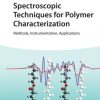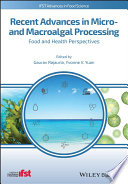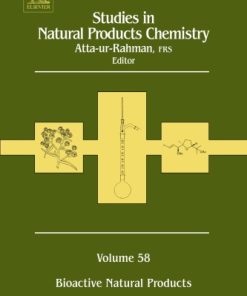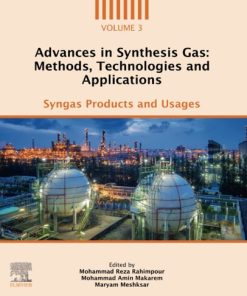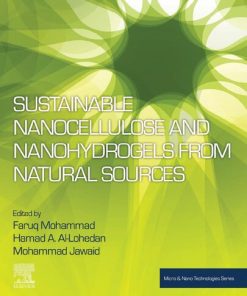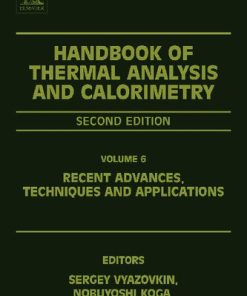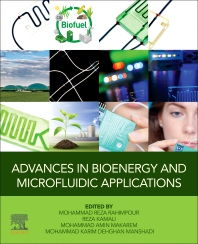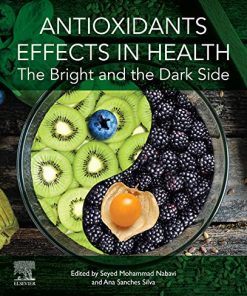Recent Advances in Natural Products Analysis 1st Edition by Seyed Mohammad Nabavi, Mina Saeedi, Seyed Fazel Nabavi Publisher Elsevier 0128175192 9780128175194
$50.00 Original price was: $50.00.$25.00Current price is: $25.00.
Recent Advances in Natural Products Analysis 1st Edition by Seyed Mohammad Nabavi, Mina Saeedi, Seyed Fazel Nabavi Publisher Elsevier – Ebook PDF Instant Download/DeliveryISBN: 0128175192, 9780128175194
Full download Recent Advances in Natural Products Analysis 1st Edition after payment.
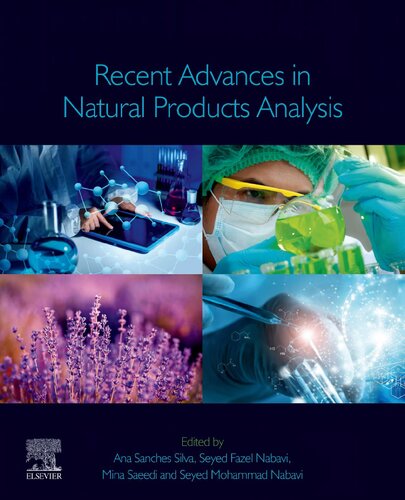
Product details:
ISBN-10 : 0128175192
ISBN-13 : 9780128175194
Author : Seyed Mohammad Nabavi, Mina Saeedi, Seyed Fazel Nabavi Publisher Elsevier
Recent Advances in Natural Products Analysis is a thorough guide to the latest analytical methods used for identifying and studying bioactive phytochemicals and other natural products. Chemical compounds, such as flavonoids, alkaloids, carotenoids and saponins are examined, highlighting the many techniques for studying their properties. Each chapter is devoted to a compound category, beginning with the underlying chemical properties of the main components followed by techniques of extraction, purification and fractionation, and then techniques of identification and quantification. Biological activities, possible interactions, levels found in plants, the effects of processing, and current and potential industrial applications are also included.
Recent Advances in Natural Products Analysis 1st Table of contents:
Part I: Introduction to natural products analysis
Chapter 1: Introduction to natural products analysis
Abstract
Acknowledgment
Conflict of interest
1.1 Introduction
1.2 Extraction of natural products
1.3 Isolation and purification of natural products
1.4 Structural elucidation of the phytochemicals
1.5 Applications of natural products and phytochemicals
1.6 Conclusion
Part II: Phenolics
Chapter 2: Analysis of monophenols
Abstract
2.1 Introduction
2.2 Phytochemistry of representative monophenols
2.3 Origins and biodegradation of monophenols
2.4 Biological activity of monophenols
2.5 Toxicity of monophenols
2.6 Current and potential industrial applications of monophenols
2.7 Techniques of extraction, purification, and fractionation
2.8 Techniques of identification and quantification
2.9 Levels found in plant/food-based plants
2.10 Effect of food processing
2.11 Trends and concluding remarks
Chapter 3: Analysis of polyphenolics
Introduction
subchapter 3.1 Flavonoids (flavones, flavonols, flavanones, flavanonols, flavanols or flavan-3-ols, isoflavones, anthocyanins, chalcones/coumestans)
subchapter 3.2 Glycosidic derivatives of flavonoids
subchapter 3.3 Isoflavonoids
subchapter 3.4 Lignans and flavonolignans
subchapter 3.5 Stilbenoids
subchapter 3.6 Tannins (hydrolysable tannins, condensed tannins, phlorotannins, flavono-ellagitannins)
subchapter 3.7 Curcuminoids
subchapter 3.8 Coumarin
subchapter 3.9 Phloroglucinols, xanthones and anthrones
Chapter 4: Analysis of aromatic acids (phenolic acids and hydroxycinnamic acids)
Abstract
In memoriam
4.1 Introduction
4.2 Phenolic acids and human health
4.3 Conjugation reactions for metabolite formation
4.4 Conclusion
Chapter 5: Analysis of phenylethanoids and their glycosidic derivatives
Abstract
5.1 Introduction
5.2 Phenylpropanoid biosynthesis
5.3 Phytochemistry and classification of the group
5.4 Chemotaxonomy
5.5 Biological activities of phenylethanoids
5.6 Phenylpropanoid occurrence in foods
5.7 Effects of food processing on phenylpropanoids
5.8 Conclusions
Chapter 6: Analysis of other phenolics (capsaicin, gingerol, and alkylresorcinols)
Abstract
Acknowledgments
Conflict of interest
6.1 Introduction
6.2 Capsaicin
6.3 Gingerol
6.4 Alkylresorcinols
6.5 Trends and remarks
Part III: Terpenes and terpenoids
Chapter 7: Analysis of monoterpenes and monoterpenoids
Abstract
7.1 Introduction
7.2 Phytochemistry of representative monoterpenes and monoterpenoids
7.3 Origins of monoterpenes and monoterpenoids
7.4 Biological activities and possible interactions
7.5 Current and potential industrial applications
7.6 Techniques of extraction, purification, and fractionation
7.7 Techniques of identification and quantification
7.8 Levels founds in plants/food-based plants
7.9 Trends and concluding remarks
Chapter 8: Analysis of sesquiterpenes and sesquiterpenoids
Abstract
8.1 Introduction
8.2 Structure and classification of sesquiterpenes and sesquiterpenoids
8.3 Biosynthesis of sesquiterpenes and sesquiterpenoids
8.4 Extraction methods of sesquiterpenes and sesquiterpenoids
8.5 Analysis of sesquiterpenes and sesquiterpenoids
8.6 Analysis of sesquiterpenes and sesquiterpenoids
8.7 Conclusion
Chapter 9: Analysis of diterpenes and diterpenoids
Abstract
9.1 Introduction
9.2 Properties and classification of diterpenes
9.3 Importance of chromatography in diterpenes analysis
9.4 Effects of processing in the phytochemicals
9.5 Conclusion
Chapter 10: Sesterterpenoids
Abstract
10.1 Introduction
10.2 Phytochemistry and classification of the group
10.3 Main representatives of the group
10.4 Ethnopharmacology
10.5 Techniques of extraction and purification
10.6 Techniques for identification and quantification
10.7 Levels found in foods/plants
10.8 Effects of food processing in the phytochemicals
10.9 Main conclusions
Chapter 11: Analysis of triterpenes and triterpenoids
Abstract
11.1 Introduction
11.2 Steroids
11.3 Saponins
11.4 Phytoecdysteroids
11.5 Conclusion
Chapter 12: Analysis of tetraterpenes and tetraterpenoids (carotenoids)
Abstract
12.1 Introduction
12.2 Phytochemistry, classification, and biosynthesis
12.3 Representatives carotenoids
12.4 Ethnophytopharmacology
12.5 Techniques of extraction and purification
12.6 Techniques of identification and quantification
12.7 Levels in foods and effects of food processing on carotenoids content
12.8 Pharmaceutical applications
12.9 Main conclusions
Chapter 13: Analysis of pentaterpenoids
Abstract
13.1 Introduction
13.2 Main representatives of the group
13.3 Ethnopharmacology
13.4 Techniques of extraction and purification
13.5 Techniques of identification and quantification
13.6 Levels found in food/plants
13.7 Effects of food processing in the phytochemicals
13.8 Pharmaceutical applications
13.9 Conclusion
Chapter 14: Analysis of meroterpenoids
Abstract
14.1 Introduction
14.2 Chemistry and classification of meroterpenoids
14.3 Meroterpenoid pharmacology
14.4 Meroterpenoids: From complex natural matrices to pure compounds
14.5 Conclusions
Part IV: Other groups of natural compounds
Chapter 15: Analysis of alkaloids (indole alkaloids, isoquinoline alkaloids, tropane alkaloids)
Abstract
15.1 Introduction
15.2 Phytochemistry and classification of alkaloids
15.3 The biological activity of alkaloids
15.4 Techniques of extraction, purification
15.5 Techniques of identification and quantification
15.6 Current and potential industrial applications of alkaloids
15.7 Conclusion
Chapter 16: Analysis of amines
Abstract
16.1 Introduction and scope
16.2 Structure and properties of representative biogenic amines
16.3 Biological activities and toxicological effects of biogenic amines
16.4 Possible interactions among different biogenic amines
16.5 Current and potential industrial applications of biogenic amines
16.6 Techniques of extraction, purification, and fractionation
16.7 Techniques of identification and quantification
16.8 Concentration levels of biogenic amines found in plants/food-based plants
16.9 Effect of food processing in phytochemistry of biogenic amines
16.10 Trends and concluding remarks
Chapter 17: Analysis of betalains (betacyanins and betaxanthins)
Abstract
17.1 Introduction
17.2 Phytochemistry and classification of the group
17.3 Main representatives of the group
17.4 Biological and medicinal properties of betalains
17.5 Techniques of extraction and purification
17.6 Techniques of identification and quantification
17.7 Accumulation and levels of betalains in Caryophyllales plants
17.8 Factors affecting stability of betalains
17.9 Pharmaceutical potential and applications
17.10 Main conclusions
Chapter 18: Analysis of carbohydrates (monosaccharides, polysaccharides)
Abstract
Acknowledgments
Conflict of interest
18.1 Phytochemistry (structure and properties) of carbohydrates
18.2 Biological activities of carbohydrates
18.3 Current and potential industrial applications of carbohydrates
18.4 Possible interactions of carbohydrates with drugs/foods
18.5 Techniques of extraction, purification, and fractionation of carbohydrates
18.6 Techniques for the identification and quantification of carbohydrates
18.7 Amounts of carbohydrates in plants/food-based plants
18.8 Effects of food processing on the phytochemicals
18.9 Trends and concluding remarks
Chapter 19: Analysis of chlorophylls
Abstract
Acknowledgments
19.1 Introduction
19.2 Phytochemistry
19.3 Classification of chlorophyll molecule
19.4 Main representatives of the group
19.5 Ethnophytopharmacology
19.6 Techniques of extraction and purification
19.7 Techniques of identification and quantification
19.8 Levels founds in foods/plants
19.9 Pharmaceutical applications
19.10 Conclusion
Chapter 20: Analysis of glucosinolates
Abstract
20.1 Introduction
20.2 Chemistry
20.3 Natural abundance
20.4 Use of glucosinolates in food and medicine
20.5 Techniques of extraction and purification
20.6 Main conclusions
Chapter 21: Analysis of gums and mucilages
Abstract
21.1 Introduction
21.2 Classification of gums and mucilages
21.3 Chemical and physical characteristics of gums and mucilages
21.4 Techniques of extraction and purification
21.5 Techniques of identification of gums
21.6 Techniques of identification of mucilages
21.7 Influences of manufacture processing on product quality and commercialization
21.8 Purity versus impurity profile
21.9 Pharmacological and industrial applications
21.10 Toxicity
21.11 Main conclusions
Chapter 22: Analysis of plants lipids
Abstract
Acknowledgment
Conflict of interest
22.1 Phytochemistry of the plants lipids
22.2 Biological activities of plants lipids
22.3 Current and potential industrial applications of plants lipids
22.4 Possible interactions of plants lipids
22.5 Techniques of extraction, purification, and fractionation of plants lipids
22.6 Techniques of identification and quantification of plants lipids
22.7 Levels founds of plants lipids in plants/food-based plants
22.8 Effects of food processing on plants lipids
22.9 Pharmaceutical applications of plants lipids
22.10 Trends and concluding remarks
Chapter 23: Analysis of polyacetylenes
Abstract
23.1 Introduction
23.2 Phytochemistry and classification of the group
23.3 Main representatives of PA
23.4 Ethnophytopharmacoloy and pharmaceutical applications of PA
23.5 Analysis and isolation of PA
23.6 Effect of food processing on PA
23.7 Conclusions
Chapter 24: Analysis of proteins, peptides, and amino acids
Abstract
Acknowledgments
Conflict of interest
24.1 Phytochemistry and classification of the proteins, peptides, and amino acids
24.2 Biological activities of protein, peptides, and amino acids
24.3 Current and potential industrial applications of protein, peptides, and amino acids
24.4 Possible interactions of proteins, peptides, and amino acids with other drugs/food/supplements
24.5 Protein, peptides, and amino acids techniques of extraction, purification, and fractionation
24.6 Protein, peptides, and amino acids techniques of identification and quantification
24.7 Levels of proteins, peptides, and amino acids in plants/food-based plants
24.8 Effects of food processing on proteins, peptides, and amino acids
24.9 Trends and concluding remarks
Chapter 25: Analysis of quinonoids
Abstract
Acknowledgment
Author contributions
Conflict of interest
25.1 Phytochemistry of the quinonoids
25.2 Biological activities of quinonoids
25.3 Current and potential industrial application of quinonoids
25.4 Possible interactions of quinonoids
25.5 Techniques of extraction, purification, and fractionation of quinonoids
25.6 Techniques of identification and quantification of quinonoids
25.7 Levels of quinonoids found in plants/food-based plants
25.8 Effects of food processing on quinonoids
25.9 Trends and concluding remarks
Chapter 26: Analysis of organic acids
Abstract
26.1 Introduction
26.2 Phytochemistry
26.3 Classification
26.4 Plant organic acids
26.5 Main representatives of the group
26.6 Ethnophytopharmacology
26.7 Techniques of extraction and purification
26.8 Techniques of identification and quantification
26.9 Levels found in foods/plants
26.10 Effects of food processing in the phytochemicals
Chapter 27: Future perspectives in natural products analysis
Abstract
27.1 Introduction
27.2 Identification and quantification of natural products
27.3 Concluding remarks
People also search for Recent Advances in Natural Products Analysis 1st:
review of natural products
advances in natural products research
recent advances in food analysis 2022
recent advances in natural products science
recent advances in natural product discovery
Tags: Recent Advances, Natural Products, Seyed Mohammad Nabavi, Mina Saeedi, Seyed Fazel Nabavi Publisher Elsevier
You may also like…
Chemistry - Organic Chemistry
Recent Advances in Micro- and Macroalgal Processing Gaurav Rajauria
Chemistry - Biochemistry
Technique - Nanotechnology
Sustainable Nanocellulose and Nanohydrogels from Natural Sources 1st Edition Faruq Mohammad
Engineering
Relationships & Lifestyle - Diet & Nutrition
Antioxidants Effects in Health: The Bright and the Dark Side 1st Edition
Science (General)
Medicine - Others
Antioxidants Effects in Health 1st edition by Seyed Mohammed Nabavi 0128190975 9780128190975


